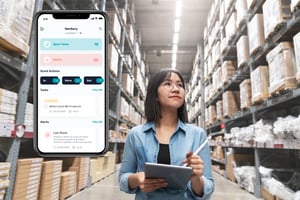For most companies, inventory is one of their highest costs and ties up most working capital. Yet,...
Harness Effective Inventory Control: Boosting OTIF Scores for Success
On-time and in-full (OTIF) delivery is crucial for maintaining customer satisfaction and ensuring operational efficiency. One key factor that can significantly impact OTIF scores is effective inventory control. By implementing robust inventory management practices, companies can streamline their operations, reduce delays, and ultimately achieve higher OTIF scores. In this blog post, we will explore how inventory control positively impacts a company's OTIF scores and discuss the key strategies for achieving better results.
- Improving Order Accuracy: Accurate inventory control ensures that stock levels align with customer demands. By implementing real-time tracking systems and employing automated inventory management solutions, companies can minimize errors in order fulfillment. This accuracy not only helps prevent stockouts and overstocks but also ensures that the right products are available to meet customer requirements promptly.
- Optimal Inventory Levels: Maintaining the right balance between supply and demand is critical for achieving high OTIF scores. Excessive inventory levels can tie up capital, occupy valuable warehouse space, and increase the risk of obsolete stock. On the other hand, insufficient inventory can result in stockouts, delayed deliveries, and dissatisfied customers. With inventory control, businesses can minimize stockouts, overstocking, and the associated delays, leading to improved OTIF performance.
- Efficient Order Processing: Inventory control goes hand in hand with efficient order processing. By utilizing inventory management software and automation tools, companies can streamline their order processing workflows. These tools help optimize picking, packing, and shipping processes, reducing errors, and improving order accuracy. Timely and error-free order processing ensures that products are readily available for shipment, increasing the chances of meeting delivery deadlines and boosting OTIF scores.
- Communication and Collaboration: Inventory control is not solely an internal effort; it requires collaboration with suppliers. Establishing strong partnerships with reliable suppliers is crucial for maintaining consistent inventory replenishment. By fostering open lines of communication, sharing demand forecasts, and implementing vendor-managed inventory (VMI) programs, companies can enhance supplier responsiveness and minimize lead times. These collaborative efforts contribute to a smoother supply chain, reducing delays and positively impacting OTIF scores.
- Real-Time Visibility: Leveraging technology solutions, such as warehouse management systems and tracking, provides real-time visibility into inventory levels, movement, and location. This enhanced visibility enables proactive decision-making, prevents stockouts or overstocking, and facilitates accurate order fulfillment. By having a clear picture of inventory status across the supply chain, companies can identify potential bottlenecks and take corrective actions to ensure on-time deliveries, thereby elevating their OTIF scores.
In conclusion, efficient inventory control is a fundamental aspect of achieving high OTIF scores. By optimizing inventory levels, streamlining order processing, nurturing supplier relationships, and leveraging real-time visibility, companies can enhance their OTIF performance. The positive impact of inventory control goes beyond meeting delivery deadlines; it also contributes to improved customer satisfaction, reduced costs, and enhanced overall operational efficiency. Embracing inventory control as a strategic priority can position businesses for long-term success in today's highly competitive market



